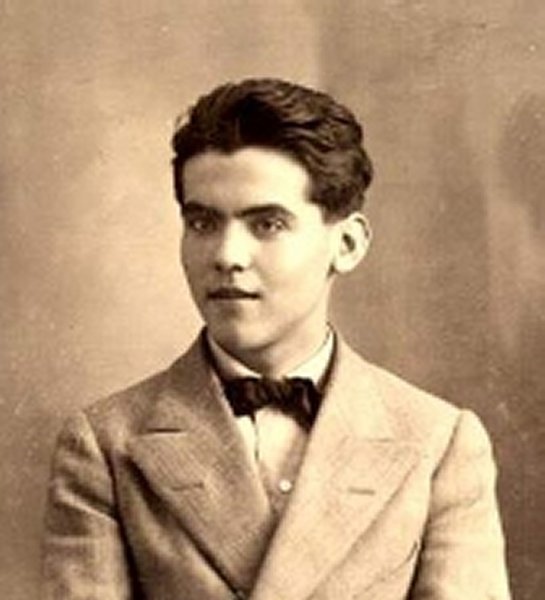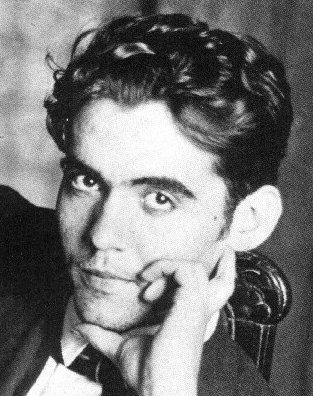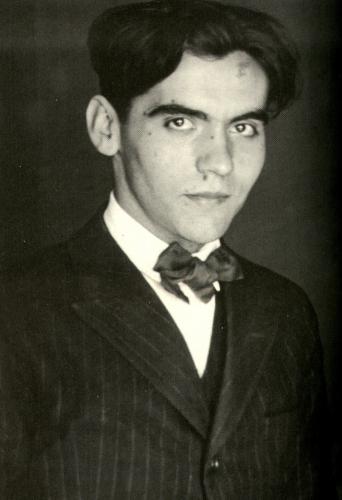<Back to Index>
- Political Economist John Maynard Keynes, 1883
- Poet Federico García Lorca, 1898
- General José Doroteo Arango Arámbula (Pancho Villa), 1878



Federico García Lorca (5 June 1898 – 19 August 1936) was a Spanish poet, dramatist and theatre director. García Lorca achieved international recognition as an emblematic member of the Generation of '27. He is thought to be one of the many thousands who were 'disappeared' and executed by Nationalists at the beginning of the Spanish Civil War. In 2008, a Spanish judge opened an investigation into Lorca's death. Lorca's family dropped objections to the excavation of a possible gravesite near Alfacar but no human remains were found.
García Lorca was born on 5 June 1898, in Fuente Vaqueros, a small town a few miles from Granada in Spain. His father owned a farm in the fertile vega surrounding Granada and a comfortable villa in the heart of the city. His mother was a gifted pianist. In 1909, his family moved to the city of Granada. In 1915, after graduating from secondary school, García Lorca attended Sacred Heart University. During this time his studies included law, literature, composition and piano. During 1916 and 1917, García Lorca traveled throughout Castile, Léon, and Galicia, in northern Spain, with a professor of his university, who also encouraged him to write his first book, Impresiones y Paisajes (Impressions and Landscapes – published 1918).
His time at Granada's Arts Club furnished him with influential associations that would prove useful following his move, in 1919, to the Residencia de estudiantes in Madrid. Here he would befriend Manuel de Falla, Luis Buñuel and Salvador Dalí and many other creative artists who were, or would become, influential across Spain. In Madrid, he met Gregorio Martínez Sierra, the Director of Madrid's Teatro Eslava. In 1919–20, at Sierra's invitation, he wrote and staged his first play, El maleficio de la mariposa . It was a verse play dramatising the impossible love between a cockroach and a butterfly, with a supporting cast of other insects; it was laughed off stage by an unappreciative public after only four performances and influenced García Lorca's attitude to the theatre-going public for the rest of his career. He would later claim that Mariana Pineda, written in 1927, was, in fact, his first play.
Over
the next few years García Lorca became increasingly involved in
Spain's avant-garde. He published poetry collections including Canciones (Songs) and Romancero Gitano (translated as Gypsy Ballads, 1928), his best known book of poetry. The poem Romance Sonambulo (Ballad of the Sleepwalker) begins with the refrain:
| Verde que te quiero verde. Verde viento. Verdes ramas. El barco sobre la mar y el caballo en la montaña. Con la sombra en la cintura ella sueña en su baranda, verde carne, pelo verde, con ojos de fría plata. Verde que te quiero verde… |
Green, how I want you green. Green wind. Green branches. The ship out on the sea and the horse on the mountain. With the shade around her waist she dreams on her balcony, green flesh, her hair green, with eyes of cold silver. Green, how I want you green… |
His second play Mariana Pineda, with stage settings by Dalí, opened to great acclaim in Barcelona in 1927. In 1926, García Lorca wrote the play The Shoemaker's Prodigious Wife which would not be shown until the early 1930s. It was a farce about fantasy, based on the relationship between a flirtatious, petulant wife and a hen-pecked shoemaker.
From 1925 to 1928 he was passionately involved with Salvador Dalí. The friendship with Lorca had a strong element of mutual passion, but Dalí rejected the erotic advances of the poet. Towards the end of the 1920s, García Lorca became increasingly depressed, a situation exacerbated by his anguish over his homosexuality. The success of Romancero Gitano intensified a painful and personal dichotomy: he was trapped between the persona of the successful author, which he was forced to maintain in public, and the tortured, authentic self, which he could only acknowledge in private. Growing estrangement between García Lorca and his closest friends reached its climax when surrealists Dalí and Luis Buñuel collaborated on their 1929 film Un Chien Andalou (An Andalusian Dog). García Lorca interpreted it, perhaps erroneously, as a vicious attack upon himself and the film ended García Lorca's affair with Dalí. At this time Dalí also met his future wife Gala. His intensely passionate but fatally one-sided affair with the sculptor Emilio Aladrén was also collapsing as the latter became involved with his future wife. Aware of these problems (though not perhaps of their causes), García Lorca's family arranged for him to take a lengthy visit to the United States in 1929–30. While in America, García Lorca stayed mostly in New York City, where he studied briefly at Columbia University School of General Studies. His collection Poeta en Nueva York explores alienation and isolation through some graphically experimental poetic techniques. His Play El Público (The Public) was not published until the late 1970s and has never been published in its entirety (the manuscript is lost).
Lorca kept Huerta de San Vicente as his summer house in Granada from 1926 to 1936. Here he wrote, totally or in part, some of his major works, among them When Five Years Pass (Así que pasen cinco años (1931), Blood Wedding (Bodas de sangre) (1932), Yerma (1934) and Diván del Tamarit (1931–1936). The poet lived in the Huerta de San Vicente in the days just before his arrest and assassination in August 1936. Although García Lorca's artwork doesn't often receive attention he was also a keen artist.
His return to Spain in 1930 coincided with the fall of the dictatorship of Primo de Rivera and the re-establishment of the Spanish Republic. In 1931, García Lorca was appointed as director of a university
student theatre company, Teatro Universitario la Barraca (The Shack).
This was funded by the Second Republic's Ministry
of Education, and it was charged with touring Spain's remotest rural
areas in order to introduce audiences to radically modern
interpretations of classic Spanish theatre. As well as directing,
García Lorca also acted. While touring with La Barraca, he wrote his now best-known plays, the Rural Trilogy of Bodas de Sangre (Blood Wedding), Yerma and La Casa de Bernarda Alba (The House of Bernarda Alba). He distilled his theories on artistic creation and performance in a famous lecture Play and Theory of the Duende, first given in Buenos Aires in
1933. García Lorca argued that great art depends upon a vivid
awareness of death, connection with a nation's soil, and an
acknowledgment of the limitations of reason. The group's subsidy was cut in half by the new government in 1934, and la Barraca's last performance was given in April 1936. García Lorca left Madrid for Granada only three days before the Spanish Civil War broke
out (July 1936). The Spanish political and social climate had greatly
intensified after the murder of prominent monarchist and anti-Popular Front spokesman José Calvo Sotelo by Republican Assault Guards (Guardia de Asalto). García Lorca was aware that he was heading towards a city held to be the most conservative in Andalusia.
On 18 August (a month after the military insurrection had broken out)
his brother-in-law, Manuel Fernández-Montesinos, the socialist
mayor of Granada, was shot. Lorca was arrested that same afternoon. It is thought that García Lorca was shot and killed by Nationalist militia on 19 August 1936. The writer Ian Gibson in his book The Assassination of Garcia Lorca states
that he was shot with three others (naming Joaquin Arcollas Cabezas,
Francisco Galadi Mergal and Dioscoro Galindo Gonzalez as fellow
victims) at a place known as the Fuente Grande, or Fountain of Tears in
Arabic, which is on the road between Viznar and Alfacar. Significant
controversy remains about the motives and details of his death.
Personal, non-political motives have also been suggested. García
Lorca's biographer, Stainton, states that his killers made remarks
about his sexual orientation, suggesting that it played a role in his
death. Ian Gibson states
that García Lorca's assassination was part of a campaign of mass
executions directed to eliminate all the supporters of the Popular Front. Gibson proposes that it is likely that rivalry between right wing groups was a major factor in his death; Former CEDA Parliamentary
Deputy, Ramon Ruiz Alonso not only arrested García Lorca at the
Rosales' home, but also the one responsible for the original
denunciation that led to the arrest warrant being issued. It has been
argued that García Lorca was apolitical and had many friends in
both Republican and Nationalist camps. Gibson questions this in his 1978 book on the poet's death. He cites, for example, Mundo Obrero's published manifesto, which Lorca later signed, indicating he was an active supporter of the (left wing) Popular Front. Lorca read this manifesto out at a banquet in honour of fellow poet Rafael Alberti on 9 February 1936. It is beyond question that other anti-communist poets were sympathetic to Lorca or assisted him; Roy Campbell for
example translated his work. In the days before his arrest he found
shelter in the house of the artist and leading (right wing) Falange member, Luis Ortiz Rosales. Indeed, evidence suggests that Rosales was very nearly shot as well for
helping García Lorca by the Civil Governor Valdes. The Basque poet and Communist Gabriel Celaya wrote in his memoirs that he once found García Lorca in the company of Falangist José Maria Aizpurua. Celaya wrote that Lorca dined with Falangist leader José Antonio Primo de Rivera every Friday. On 11 March 1937 an article appeared in the Falangist press
criticizing the murder and lionizing García Lorca; the article
opened: "The finest poet of Imperial Spain has been assassinated." There was also the 'homosexual jealousy' theory that was published by Jean-Louis Schonberg. "Then
I realised I had been murdered. They looked for me in cafes, cemeteries
and churches .... but they did not find me. They never found me? No.
They never found me." Franco's Falangist regime placed a general ban on García Lorca's work, which was not rescinded until 1953. That year, a (censored) Obras Completas (Complete works) was released. Following this, Bodas de Sangre (Blood Wedding), Yerma and La casa de Bernarda Alba were successfully played in the main Spanish stages. Obras Completas did not include his late heavily homoerotic Sonnets of Dark Love,
written in November 1935 and shared only with close friends. They were
lost until 1983/4 when they were finally published in draft form (no
final manuscripts have ever been found.) It was only after Franco's
death that García Lorca's life and death could be openly
discussed in Spain. This was due, not only to political censorship, but
also to the reluctance of the García Lorca family to allow
publication of unfinished poems and plays prior to the publication of a
critical edition of his works. In
late October 2009, a team of archaeologists and historians from the
University of Granada began excavations outside Alfácar. The site was identified three decades ago by a man who claimed to have helped dig Lorca's grave. Lorca
was thought to be buried with at least three other men beside a winding
mountain road that connects the villages of Viznar and Alfácar. There is a growing desire in Spain to come to terms with the civil war, which for decades was not openly discussed. The
judge in the case, Judge Garzon, formally requested local government
and churches to open their files on the thousands of people who
disappeared during the Civil War and under the dictatorship of General Franco until 1975. The excavations began at the request of another victim's family. Following a long-standing objection, the Lorca family also gave their permission. In October 2009 Francisco Espinola, a spokesman for the Justice Ministry of the Andalusian regional government, said that after years of pressure García Lorca's body would "be exhumed in a matter of weeks". Lorca's
relatives, who had initially opposed an exhumation, said they might
provide a DNA sample in order to identify his remains. In
late November 2009, after two weeks of excavating the site, organic
material believed to be human bones was recovered. The remains were
taken to the University of Granada for examination. But in mid December, 2009, doubts were raised as to whether the poet's remains would be found. The
dig produced "not one bone, item of clothing or bullet shell", said
Begona Alvarez, justice minister of Andalucia. She added, "the soil was
only 40cm (16in) deep, making it too shallow for a grave". García Lorca is honored by a statue prominently located in Madrid's
Plaza de Santa Ana. Political philosopher David Crocker reports that
"the statue, at least, is still an emblem of the contested past: "each
day, the Left puts a red kerchief on the neck of the statue, and
someone from the Right comes later to take it off." The
Lorca Foundation, directed by Lorca's niece Laura García Lorca,
sponsors the celebration and dissemination of the writer's work and is
currently building the Lorca Centre in Madrid. The Lorca family gave all Lorca's documentation to the foundation which holds it on their behalf. The García Lorca family summer home at Huerta de San Vicente was
opened to the public in 1995 as a museum. The grounds, including nearly
two hectares of land, the two adjoining houses, artworks and the
original furnishings have been preserved.
The dossier on the murder, compiled at Franco's request, and referred to by Gibson and others has yet to surface. Jan Morris describes how García Lorca foretold his own fate